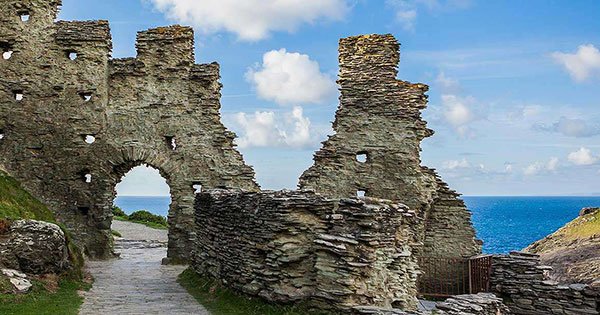High up on the cliffs on the wild Atlantic coast of north Cornwall stand the ruins of Tintagel Castle. Its romantic associations with the legend of King Arthur and his Knights of the Round Table makes this an intriguing place to visit, although Geoffrey of Monmouth, who wrote his history of King Arthur’s having been born here, was writing well before the time that the castle was built.
It’s thought that Tintagel Castle became so inextricably linked with the legends of King Arthur that a succession of owners decided to keep the legends alive and maintain the tenuous links despite not being able to base them on historical fact.

Originally a more extensive castle, large landslips over the years have created a large valley between the two remaining parts of the building, making access to the island possible only by using the steep stairs constructed for the purpose, although access is possible via the beach.
The area around Tintagel has revealed much evidence of settlement and activity throughout the long centuries, dating back to the Roman occupation when tin was already being mined. According to Raleigh Radford, who undertook major archaeological excavations, in the period following the departure of the Romans from Britain the site of Tintagel Castle was used as a prominent Celtic monastery and possibly as a fortification and some kind of trading post. The name of Tintagel is likely to be the fortifications referred to in the fifth and sixth centuries as Din Tagell, or the fort with the constricted entrance, and looking at old plans one can see that entrance to the castle is via a very narrow access route.
It doesn’t seem likely that the fortification would have had much strategic or military purpose, given that the castle is not best placed to make it an effective stronghold against invasion and attack. The castle that we see today was first built in 1233 by Richard the Earl of Cornwall, brother to Henry III, although historically it had no strategic importance apart from its tenuous links with Arthur.
Later Earls of Cornwall had no use for Tintagel Castle and it was left uninhabited, and by the fourteenth century its roof had already disappeared, either because it had fallen in or because it had been removed. By the fifteenth century Tintagel Castle was in ruins.
The legends of King Arthur continue to haunt these intriguing ruins. In 1998 a further archaeological dig revealed an artefact that has become known as Arthur’s Stone, being inscribed with what many are convinced is evidence of Arthur having lived in this area in about the fifth or sixth century, a suggestion reinforced by the inscriptions on the stone which refer to a King Coll and Artognou, a descendant of Arthur.
Whatever the facts behind the legend of King Arthur, Tintagel Castle will no doubt always be associated with the King and his Round Table, and is probably one of the reasons why it is one of the historic castles of the UK held in such great affection by the British.
Tintagel Castle is now owned and maintained by English Heritage. Details of visiting times and ticket prices are detailed on their Tintagel Castle page.